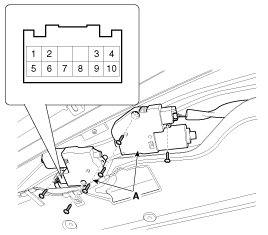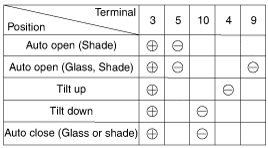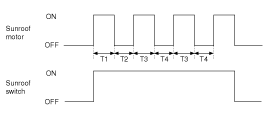| 1. |
Disconnect the negative (-) battery
terminal. |
| 2. |
Remove the roof trim.
(Refer to the BD group - "Roof
trim") |
| 3. |
Disconnect the panoramaroof motor (A)
connector.

|
| 4. |
Ground the terminals as below table, and check
that the panoramaroof unit operates.
| -
|
When inspecting the panoramaroof
motor operation, panoramaroof motor and roller blind
motor always should be
connected. | |

|
| 5. |
Make these input tests at the connector. If
any test indicates a problem, find and correct the cause, then
recheck the system. If all the input tests prove OK, the sunroof
motor must be faulty; replace it.
Terminal
|
Test
condition
|
Test: Desired
result
|
3
|
IG2
ON
|
Check
for voltage to ground:
There should
be battery voltage.
|
1
|
Under
all
conditions
|
Check
for continuity to ground:
There
should be continuity.
|
6
|
Under
all
conditions
|
Check
for voltage to ground:
There should
be battery
voltage.
|
|
| 6. |
Ground the terminal as below table, and check
the roller blind motor operates.

|
| Resetting The
Panoramaroof |
Whenever the vehicle
battery is disconnected or discharged, or you use the emergency handle to
operate the panoramaroof, you have to reset your sunroof system as follows
:
| 1. |
Turn the ignition key to the ON position and
then close the panoramaroof
completely. |
| 2. |
Release the panoramaroof control
lever. |
| 3. |
Press and hold the CLOSE button for more than
10 seconds until the panoramaroof closed and it has moved
slightly. |
| 4. |
Release the panoramaroof control
lever. |
| 5. |
Press and hold the CLOSE button once again
within 5 seconds until the panoramaroof do as follows;
| A. |
Tilt → Slide Open → Slide
Close
Then release the
lever. | |
| 6. |
Reset procedure of panorama system is
finished. |
Protecting Motor From Overheating
In order to protect the
panoramaroof motor from overheating from continuous motor operation, the
panoramaroof ECU controls the Run-time and Cool-time of the motor as
follows:
| 1. |
The panoramaroof ECU detects the Run- time of
motor |
| 2. |
Motor can be operated continuously for the 1st
run-time(120 ± 10sec.). |
| 3. |
The continuous operation of motor stops after
the 1st Run-time(120 ± 10sec.). |
| 4. |
Then Motor is not operated for the 1st
Cool-time(18 ± 2sec.). |
| 5. |
Motor is operated for the 2nd Run-time(10 ±
2sec.) at the continued motor operation after 1st Cool-time(18 ±
2sec.) |
| 6. |
The continuous operation of motor stops
operating after the 2nd Run-time(10 ±
2sec.) |
| 7. |
Motor is not operated for the 2nd Cool-time(18
± 2sec.). |
| 8. |
Motor repeats the 2nd run-time and 2nd
cool-time at the continued motor operation.
| A. |
In case that motor is not operated
continuously, the run-time is
increased. |
| B. |
The Run-Time of motor is initialized to
"0" if the battery or fuse is reconnected after being
disconnected, discharged or
blown. |

T1 : 120 ± 10 sec., T2 : 18 ± 2
sec.,
T3 : 10 ± 2 sec., T4 : 18 ± 2
sec. |